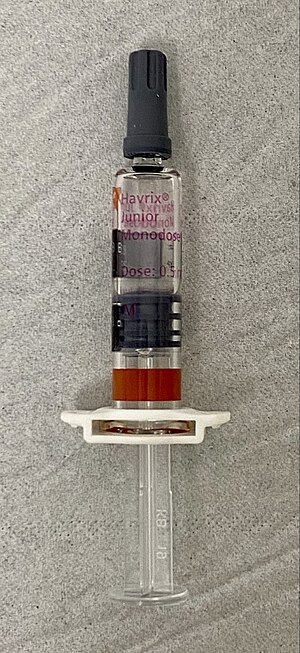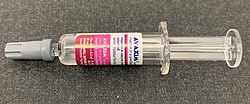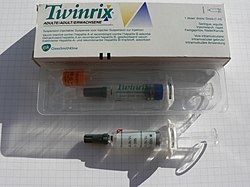Hepatitis A vaccine
 Hepatitis A (Havrix junior) vaccine for children | |
| Vaccine description | |
|---|---|
| Target disease | Hepatitis A |
| Type | Attenuated, inactivated |
| Names | |
| Trade names | Havrix, Vaqta, Avaxim, Rixansart, Mevac-A[1] |
| Clinical data | |
| Main uses | Prevent hepatitis A[1] |
| Side effects | Pain at site of injection[1] |
| Pregnancy category |
|
| Routes of use | Intramuscular |
| External links | |
| AHFS/Drugs.com | Monograph |
| MedlinePlus | a695003 |
| Legal | |
| Legal status |
|
Hepatitis A vaccine is a vaccine that prevents hepatitis A, a disease of the liver.[1] It used in children and adults, is well-tolerated, safe and effective.[2] Around 95% or more of those vaccinated get protection 2-to-4 weeks following the first dose.[1] A second dose given 6 to 12 months later provides long-term protection; possibly for a person's entire life.[3] It is given by injection into a muscle, but some brands can be injection just under skin if the person has haemophilia or is taking blood-thinning medicines.[1]
The World Health Organization (WHO) recommends universal vaccination in areas where the disease is moderately common.[1] Where the disease is very common, widespread vaccination is not recommended as all people typically develop immunity through infection during childhood.[2] As of 2018, routine hepatitis A vaccination in not part of any African country's Expanded Program on Immunization.[4] In the US, it is recommended in adults who are at high risk and all children over age one-year.[5] One dose of the vaccine, is also advised, for infants age 6-11 months who are travelling to a high risk area; but should receive the 2-dose course as usual after age one.[6] High risk groups include: certain occupations, close contacts with people with acute hepatitis A, men who have sex with men, people who use illicit drugs, people with chronic liver disease or blood clotting conditions, the homeless, and 2 to 4 weeks before travelling to areas were the disease is common.[7]
No severe side effects are linked to the vaccine.[1] Mild self-limiting pain and swelling at the site of injection occurs in about one-in-five children and half of adults.[1] Less than 5% of people receiving the vaccine may have a moderate side effect such as tiredness, low fever, diarrhoea, vomiting, and headache.[1] Most hepatitis A vaccines contain inactivated virus while a few contain weakened virus.[3] The ones with weakened virus are not recommended during pregnancy or in those with poor immune function.[3] A few formulations combine hepatitis A with either hepatitis B or typhoid vaccine.[1]
The first hepatitis A vaccine was licensed in 1992.[8] The first dose, globally, was administered in 1992.[9] It is on the World Health Organization's List of Essential Medicines.[10] In the United States it costs US$50–100.[11] In the UK, one dose of hepatitis A vaccine costs the NHS just over £20.[12] As of 2021, millions of doses have been given worldwide.[1]
Medical uses
Within the U.S., the vaccine was phased in, around 1996, for children living in high-risk areas. In 1999, it was spread to areas with elevating levels of infection. In the U.S. as of 2007[update], the vaccine is strongly recommended for all children 12 to 23 months of age in an attempt to eradicate the virus nationwide. Although the original Food and Drug Administration (FDA) license for Havrix by GlaxoSmithKline is dated in 1995,[13] it has been in use in Europe since 1993.[citation needed]
The U.S. Centers for Disease Control and Prevention (CDC), recommends vaccination of all children over one year of age, people whose sexual activity puts them at risk, people with chronic liver disease, people who are being treated with clotting factor concentrates, people working in close proximity to the virus, and people who are living in communities where an outbreak is present.[6] Hepatitis A is the most common vaccine-preventable virus acquired during travel,[14] so people traveling to places where the virus is common like the Indian subcontinent, Africa, Central America, South America, Asia, and Eastern Europe should be vaccinated.[6][15]
The vaccine is given in the muscle of the upper arm, in two doses for the best protection. The initial dose of the vaccine should be followed up by a booster six to twelve months later.[6] Protection against hepatitis A begins approximately two to four weeks after the initial vaccination.[6][15] Protection lasts at least 15 years and is estimated to last at least 25 years if the booster is administered.[16]
A Cochrane review found that both types of vaccines offer significant protection, for at least two years using the inactivated vaccine and at least five years with the attenuated vaccine. The review concluded that the inactivated vaccine is safe, but required more high quality evidence to assess the safety of the attenuated vaccine.[17][needs update]
Types
Several commercial hepatitis A vaccines are available. The definition of (U)nits varies among manufacturers depending on how hepatitis A antigen is measured in their products.
- Avaxim: made by Sanofi Pasteur. Inactivated hepatitis A virus produced in MRC-5 cells. Each dose contains 160 U of antigen adsorbed on aluminium hydroxide (0.3 mg Al).[18]
- Epaxal (no longer available)[1]: made by Crucell. Also sold under the brand names HAVpur and VIROHEP-A. This vaccine consists of virosomes, artificial particles composed of synthetic lipids and influenza proteins in addition to the hepatitis A antigen. It does not contain aluminium.[19]
- Havrix: made by GlaxoSmithKline. Inactivated hepatitis A virus produced in MRC-5 cells. Each adult dose contains 1440 ELISA units of viral antigen adsorbed on aluminium hydroxide (0.5 mg Al). The pediatric (child) doses contain half the amount of viral antigen and aluminium.[20]
- Healive: made by Sinovac. Inactivated hepatitis A virus cultured in human diploid cell, followed by harvest, purification, inactivation, and aluminium adsorption. Each adult dose contains 500 U of viral antigen. The pediatric dose contains 250 U of viral antigen.
- Vaqta: made by Merck. Inactivated hepatitis A virus produced in MRC-5 cells. An adult dose contains 50 U of antigen adsorbed onto 0.45 mg of aluminium (as aluminium hydroxyphosphate sulfate); a child dose contains half the amounts of antigen and aluminium.[21]
- Biovac-A: made by Pukang, sold under the brand name Biovac-A in India and under the brand names Mevac-A in Guatemala, Philippines, Bangladesh, Nepal, Uzbekistan and Chile etc. It is a freeze-dried live attenuated hepatitis A vaccine. Hepatitis A virus H2 strain is produced in human diploid cells. A pack of 0.5ml vial of Biovac-A and 0.5ml ampoule of SWFI (sterile water for injection), contains not be less than 6.5 Lg CCID50. Only a single dose is needed. It is recommended by the WHO. Long term persistence research data predicated that sero-conversion remained and antibody titre was not less than 128 IU/ml, 15 years after vaccination.
Combination vaccines
- Hepatitis A and B vaccine is a vaccine against hepatitis A and hepatitis B.
- Hepatitis A and typhoid vaccine is a vaccine against hepatitis A and typhoid.[22][23]
-
Avaxim - Hepatitis A vaccine for age over 16 years
-
Twinrix - combined hepatitis A and B vaccine for age over 16 years
References
- ↑ 1.00 1.01 1.02 1.03 1.04 1.05 1.06 1.07 1.08 1.09 1.10 1.11 1.12 Damme, Pierre Van; Hendricks, Greet (2021). "12. Hepatitis A vaccines". In Vesikari, Timo; Damme, Pierre Van (eds.). Pediatric Vaccines and Vaccinations: A European Textbook (Second ed.). Switzerland: Springer. pp. 115–126. ISBN 978-3-030-77172-0. Archived from the original on 20 October 2023. Retrieved 2 October 2023.
- ↑ 2.0 2.1 "Hepatitis A". www.who.int. World Health Organization. 2 June 2022. Archived from the original on 11 June 2022. Retrieved 19 June 2022.
- ↑ 3.0 3.1 3.2 World Health Organization (2012). "WHO position paper on hepatitis A vaccines - June 2012". www.who.int. World Health Organization. Archived from the original on 20 June 2022. Retrieved 19 June 2022.
- ↑ Patterson, Jenna; Abdullahi, Leila; Hussey, Gregory D.; Muloiwa, Rudzani; Kagina, Benjamin M. (22 July 2019). "A systematic review of the epidemiology of hepatitis A in Africa". BMC infectious diseases. 19 (1): 651. doi:10.1186/s12879-019-4235-5. ISSN 1471-2334. PMID 31331281. Archived from the original on 29 May 2021. Retrieved 19 June 2022.
- ↑ "Safety Information for Hepatitis A Vaccines | Vaccine Safety | CDC". www.cdc.gov. CDC. 9 September 2021. Archived from the original on 31 May 2022. Retrieved 19 June 2022.
- ↑ 6.0 6.1 6.2 6.3 6.4 Nelson, Noele P. (2021). "Hepatitis A - Chapter 4 - 2020 Yellow Book | Travelers' Health". wwwnc.cdc.gov. Archived from the original on 23 September 2019. Retrieved 19 June 2022.
- ↑ Lampiris, Harry W.; maddix, Daniel S. (2020). "Appendix: Vaccines, immune globulins, and other complex biologic products". In Katzung, Bertram G.; Trevor, Anthony J. (eds.). Basic and Clinical Pharmacology (15th ed.). New York: McGraw-Hill. p. 1228. ISBN 978-1-260-45231-0. Archived from the original on 10 October 2021. Retrieved 27 December 2021.
- ↑ Saleh, Amr; Qamar, Shahraz; Tekin, Aysun; Singh, Romil; Kashyap, Rahul (July 2021). "Vaccine Development Throughout History". Cureus. 13 (7): e16635. doi:10.7759/cureus.16635. ISSN 2168-8184. PMID 34462676. Archived from the original on 21 May 2022. Retrieved 21 May 2022.
- ↑ Zhang, Li (2 July 2020). "Hepatitis A vaccination". Human Vaccines & Immunotherapeutics. 16 (7): 1565–1573. doi:10.1080/21645515.2020.1769389. ISSN 2164-5515. PMID 32649265. Archived from the original on 28 December 2021. Retrieved 27 December 2021.
- ↑ World Health Organization (2019). World Health Organization model list of essential medicines: 21st list 2019. Geneva: World Health Organization. hdl:10665/325771. WHO/MVP/EMP/IAU/2019.06. License: CC BY-NC-SA 3.0 IGO.
- ↑ Hamilton, Richart (2015). Tarascon Pocket Pharmacopoeia 2015 Deluxe Lab-Coat Edition. Jones & Bartlett Learning. p. 314. ISBN 9781284057560.
- ↑ "14. Vaccines". British National Formulary (BNF) (82 ed.). London: BMJ Group and the Pharmaceutical Press. September 2021 – March 2022. pp. 1384–1385. ISBN 978-0-85711-413-6.
- ↑ "Hepatitis A Vaccine Information". Vaccine Information. ImmunizationInfo. Archived from the original on 30 June 2007. Retrieved 19 June 2008.
- ↑ "Hepatitis, Viral, Type A". Travelers' Health: Yellow Book (CDC). Archived from the original on 28 March 2007. Retrieved 12 March 2007.
- ↑ 15.0 15.1 "Hepatitis A: Introduction". NHS Direct. 10 October 2006. Archived from the original on 10 March 2007. Retrieved 12 March 2007.
- ↑ Ott JJ, Irving G, Wiersma ST (December 2012). "Long-term protective effects of hepatitis A vaccines. A systematic review". Vaccine. 31 (1): 3–11. doi:10.1016/j.vaccine.2012.04.104. PMID 22609026.
- ↑ Irving GJ, Holden J, Yang R, Pope D (2012). "Hepatitis A immunisation in persons not previously exposed to hepatitis A". Cochrane Database Syst Rev. 7 (7): CD009051. doi:10.1002/14651858.CD009051.pub2. PMC 6823267. PMID 22786522.
- ↑ Patient Information Leaflet Archived 20 July 2011 at the Wayback Machine, sanofi pasteur, July 2010. Archived on the electronic Medicines Compendium of the UK. Accessed 30 November 2010.
- ↑ Epaxal Archived 19 January 2011 at the Wayback Machine, Crucell website. Accessed 30 November 2010.
- ↑ Full Prescribing Information Archived 18 August 2011 at the Wayback Machine, GlaxoSmithKline, July 2010. Archived on FDA website. Accessed 30 November 2010.
- ↑ "VAQTA (Hepatitis A Vaccine, Inactivated)" (PDF). U.S. Food and Drug Administration (FDA). p. 11. Archived (PDF) from the original on 21 February 2015. Retrieved 7 February 2014.
- ↑ "Archived copy" (PDF). Archived (PDF) from the original on 4 March 2016. Retrieved 1 October 2015.
{{cite web}}: CS1 maint: archived copy as title (link) - ↑ "Archived copy". Archived from the original on 1 October 2015. Retrieved 10 April 2017.
{{cite web}}: CS1 maint: archived copy as title (link)
External links
| Identifiers: |
|
|---|
- "Hepatitis A Vaccine Information Statement". Centers for Disease Control and Prevention (CDC). Archived from the original on 25 December 2019. Retrieved 20 December 2019.
- Hepatitis A Vaccines at the US National Library of Medicine Medical Subject Headings (MeSH)
- Pages using duplicate arguments in template calls
- Pages with non-numeric formatnum arguments
- Webarchive template wayback links
- CS1 maint: archived copy as title
- Use dmy dates from June 2011
- Articles with invalid date parameter in template
- Chemical articles with unknown parameter in Infobox drug
- Chemical articles without CAS registry number
- Articles without EBI source
- Chemical pages without ChemSpiderID
- Chemical pages without DrugBank identifier
- Articles without KEGG source
- Articles without InChI source
- Articles without UNII source
- Drugs missing an ATC code
- Drugboxes which contain changes to verified fields
- Drugboxes which contain changes to watched fields
- Drugs that are a vaccine
- Articles containing potentially dated statements from 2007
- All articles containing potentially dated statements
- All articles with unsourced statements
- Articles with unsourced statements from September 2019
- Wikipedia articles in need of updating from February 2020
- All Wikipedia articles in need of updating
- Chemicals that do not have a ChemSpider ID assigned
- Hepatitis A
- Inactivated vaccines
- Vaccines
- GlaxoSmithKline brands
- Merck & Co. brands
- World Health Organization essential medicines (vaccines)
- RTT
- RTTVaccine

